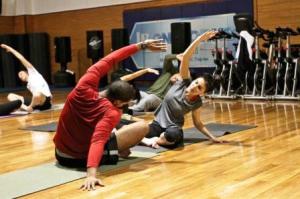Exercise and diabetes

Exercise and diabetes should go hand in hand. Exercise is a critical part of diabetic management and treatment, at nearly every level, since it is a core component of the natural energy flow. Lack of proper exercise may lead to stagnancy, which in turn could deteriorate even the smallest signs of diabetes. On the other hand, exercise helps with blood sugar control when the muscles use more glucose and the body turns more sensitive to insulin. Regular exercise routine benefits both the physical and the mental functions. Here are several tips to make exercise and diabetes live better together.
Exercise also helps to prevent and minimize common diabetic complications including heart problems, high blood pressure and circulatory deficiencies. All diabetics should include a regular exercise program as part of their overall management plan.
The two most common forms of diabetes are named Type 1 and Type 2. Type 1 diabetes, commonly known as adolescent diabetes, differs from Type 2 mainly in that the body stops the production of insulin altogether. Type 2 diabetes, on the other hand, is generally diagnosed in older adults. It occurs when the body stops producing sufficient levels of insulin, or when the individual becomes resistant to his, or her own natural insulin.
How does this relate to exercise and physical activity ?
With either form of diabetes, we tend to lose our ability to adequately utilize sugar, one of the basic sources of physical energy. While blood sugar levels increase the muscle cells remain hungry for sugar. How is that possible ? It is due to the body's lowered capability to transport sugar into the cells and out of the blood stream. Fortunately, there are various ways to lower blood sugar levels. These include exercise, proper diet, synthetic medications or natural remedies.
Since balancing blood sugar levels is critical to fighting diabetes successfully, exercise and diabetes go very well hand in hand. Exercise should always be deemed a very important part of diabetic management for both Type 1 and Type 2 diabetics.

How does exercise help with Type 1 diabetes, and does it defer from improvements seen with Type 2 diabetes ?
For the Type 1 diabetic, regular exercise helps to maintain insulin sensitivity. This is critical, as it also helps prevent the buildup of excess weight, and increases the use of glucose by muscles. All these move to lower blood sugar levels. While there is currently no way to prevent Type 1 diabetes, it may be possible to prevent Type 2 diabetes.
The main issues to consider when attempting to prevent the onset of Type 2 diabetes include regular exercise, dietary supplementation with vitamins and herbs that help prevent insulin resistance, and proper weight control, as overweight might be a gate to unnecessary complications of diabetes.
To push this point more strongly, it is important to see that exercise does not only helps directly in diabetic management by lowering blood sugar levels and maintaining insulin sensitivity. It also helps minimize many of the complications that can arise for diabetics. Medical studies have shown that walking for at least 30 minutes a day can substantially reduce the risk of developing Type 2 diabetes.
Diabetics tend to develop circulatory problems. While this might be true all over the body, special symptoms of diabetes include swollen foot and diabetic foot pain due to neuropathy in feet. Happily, exercise can certainly help lower blood pressure and improve circulation throughout the body as well as in the feet. Since diabetics tend to have poor blood flow to their lower extremities and feet, better circulation is of great benefit.
Although exercise routine should be considered crucial to leading the best lifestyle possible, there are some risks associated with exercise and awareness in recommended at all times. Nevertheless, the potential benefits greatly outweigh the risks.
Since exercise does lower blood sugar levels, it is recommended for people with diabetes that you measure your blood sugar both before and after exercising. As your body uses more sugar while exercising, and makes you more sensitive to insulin, there is a risk of blood sugar depleting, going too low, and causing hypoglycemia.
When exercising, it is important to let others know that you are diabetic:
* These may include people who train with you, exercise partners, a trainer or a coach.
* When going on your own, this may include people at home, or others that are available on a short notice by any kind of phone.
* It is best to make sure they are well informed and know exactly what to do in case you encounter hypoglycemia.
* You should always carry some kind of candy, dried fruit or fruit juice, to treat low blood sugar levels should they occur.
* During and after exercise sessions, you should pay close attention to how you feel since rapid heartbeat, increased sweating, feeling shaky, or noticeable hunger can signal that your blood sugar levels are turning too low.
Exercise is a critical part of diabetic management and diabetes of any type treatment. Exercise is a very beneficial way to help control blood sugar when the muscles use more glucose, and the body becomes more sensitive to insulin. Regular exercise also helps to prevent and minimize common diabetic complications, including heart problems, high blood pressure, diabetic neuropathy, and other circulatory deficiencies. All diabetics should include a regular exercise routine as part of their overall management plan.

Good information